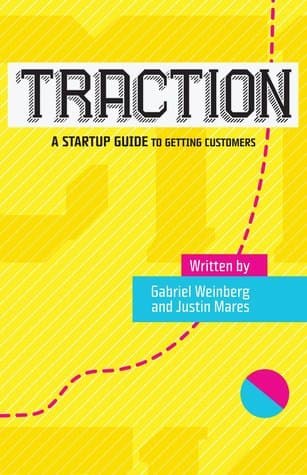
Traction: A Startup Guide to Getting Customers
by Weinberg, Gabriel
Published: August 23, 2014
Read: January 1, 2020
Review
Apparently there are 19 distinct ways to generate growth or traction for your business. 19. Really makes marketing a much more conquerable challenge instead of an engineers subjective nightmare. The book is a great intro to the marketing landscape. Basics to specific details like expected conversion tests and costs and time commitment of certain channels.
Notes
Author sold in 06 and runs duckduckgo
SEO and Viral Marketing is when you current customers bring new ones
Duckduckgo went for new search engine, and made a widget that linked back to duckduckgo
Traction is basically quantitative evidence of customer demand, cunsomuer software can be hundreds of thousands and Enterprise can be a few
Traction is growth which pg
2 main themes:
Most founders often limit themselves to channels they know or work in industry
- most underused for an industry may be best
Hard to tell what channels will work
Traction method is called bullseye and revolves around quick tests and then Joni on those that work
19 channels of growth
Blog targeting, publicity, unconvential PR(publicity stunt or eztreme service), search engine marketing which is ads on search, social or display ads, offline ads (commericals, print), SEO(show up for search results), content marketing, email marketing, engineering as marketing (widgets, side projects), viral marketing (referrals), business development (strategic relationship), sales, affiliate programs, existing platforms, trade shows, offline events sponsorship, speaking, community building
Traction thinking
Common story is entrepreneurs have a product, but work on that instead of everything else.
50% of time on traction, 50% on product
Pursuing in parallel gives you cold customers that let you get an even better idea of what people want. Slows down product development in short run, but you often need more cycles when product hits markets as well. It will be a leaky bucket but that's fine
Set traction goal
3 phases: make a product people want, market something people want, scale
Do things that don't scale
Viral and community scale with size of community, need to change what you do as you have new growth numbers
Founders often to early, and often choose their idea to quickly
Bullseye
Distribution is biggest reason for failure
Great to get at least one channel to work, most get 0 and run multiple workout thinking of what is best
Know history of your industry and marketing that worked and that didn't
Want to determine channels that might be able to scale, small tests with <1k and a month
Solely focus on channel that works after tests
One channel usually dominates some point of growth, and other channels might support it
Bullseye let's you try other channel, and soon in on the one that works and moved the needle
When channel stops moving needle, switch and redo when it stops working
Similar to lean
If you build it they will come, is wrong
Easiest way to research industry is to talk to who founders who failed
Testing
Channel strategies within a channel like print out billboards for offline ads
Cost, number available, are the customers the ones you want right now
Outer ring, to middle ring, to inner ring
Middle, Less optimization and more cheap channel test
Inner ring is optimizing
A/B Test to scientifically test change of variable like signups. Optimize ly, unbounce make it easy
Over time all marketing channels become saturated, ignored by customers or more costly. Solution is to find the next marketing strategy. Banner ads once had 70 click through. Zynga dominated Facebook channel
Track on spreadsheet, CAC, LTV, number of customers be quantitative even if guesses
Critical path
Choose what to focus on based on your traction goal for company significane
Path to hit traction goal is critical path, constantly evaluate with relation to goal, and put on calendar
Founders often ignore promising channels due to inherent biases, can almost be competitive advantage though
Every channel listed has been used as main one for both consumer and Enterprise businesses
Targeting blogs
Most effective for first wave of customers
VIP Access, and direct sponsoring
Mint was first to invite friends to get priority access to product, provide code to easily embed badge(600 blogs and 250k users, which boosts SEO link)
Motley fool partnership(business drv channel)
Sent emails with subject line can I send you $500
Sponsored appsumo giveaways and bundles with a heavy discount for blog users
Search YouTube for video creators often with blogs, blog search
Ask people what they read online, link sharing websites like hacker news
Put together guest post give early access
PR